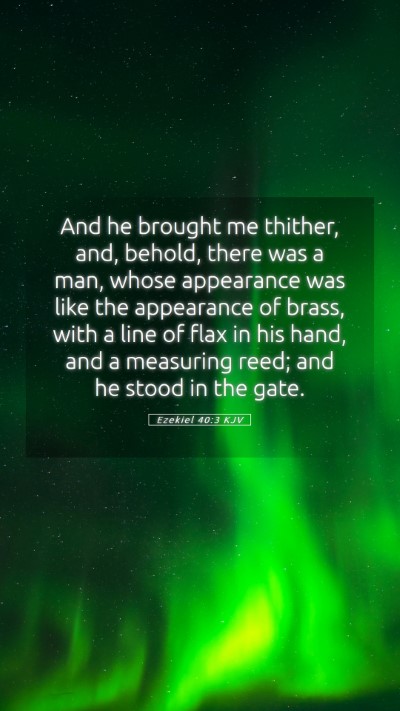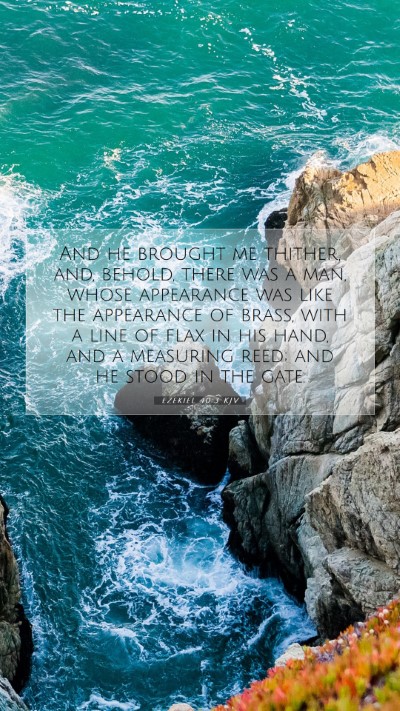Ezekiel 40:3 - In-Depth Bible Verse Analysis
Bible Verse: Ezekiel 40:3 - "And he brought me thither, and, behold, there was a man, whose appearance was like the appearance of brass, with a line of flax in his hand, and a measuring reed; and he stood in the gate."
Understanding Scripture
The verse from Ezekiel 40:3 is significant within the broader context of Ezekiel's prophecies, particularly his vision of the new temple. Here, Ezekiel describes an angelic figure, often interpreted as a heavenly messenger or a symbolic representation of God’s authority, who is tasked with measuring the dimensions of the future temple.
Bible Verse Meanings - Key Insights
The figures and objects mentioned in this verse hold profound symbolic meaning:
-
Brass: The 'appearance of brass' signifies strength and durability, suggesting that the temple will be built on a firm foundation that symbolizes God's enduring covenant with His people.
-
Line of Flax: The line of flax represents precision and care in measurement, indicating God's meticulous attention to details in His plans for His people and the temple.
-
Measuring Reed: The measuring reed symbolizes God's authority in establishing boundaries and sacred spaces, which implies that the temple is a holy place set apart for divine worship.
Bible Verse Commentary
According to Matthew Henry's Commentary, this passage illustrates God's commitment to restoration and renewal for His people. The vision in Ezekiel is not just about the physical architecture of a temple but reflects a deeper spiritual restoration of Israel. Henry highlights the significant transformation from destruction to new beginnings.
Albert Barnes adds that the angel's presence indicates authority and divine oversight. The act of measuring serves as a divine confirmation of the temple's holiness and the importance of following God's instructions. This reflects that worship must align with the divine standard.
Adam Clarke emphasizes the metaphorical use of the temple's dimensions, representing the order and structure that God desires in the lives of His people. The meticulous measurements indicate that adherence to God's law and directives is essential for true worship and communion with Him.
Bible Study Insights
For those engaged in Bible study groups or online Bible study, understanding the layers of meaning within this verse can lead to enriched discussions about God's nature and His expectations for His followers. By analyzing the text, group members can explore the significance of the temple in their daily lives and how it relates to modern worship practices.
Significance of Ezekiel 40:3
In this verse and the wider context of Ezekiel's writings, we observe several important themes:
- Divine Restoration: This verse is set in a larger narrative of restoration and hope for the Israelites after exile.
- The Holiness of God: The temple serves as a sacred space indicating God's desire to dwell among His people.
- Obedience and Structure in Worship: The specifics in the measurements highlight the importance of following God's design in worship.
Historical Context
Understanding the historical context of Ezekiel's vision helps in interpreting Bible verses effectively. Ezekiel prophesied during a tumultuous period for Israel, emphasizing the importance of returning to worship and the covenant built through the temple.
Application of the Verse to Daily Life
Believers today can apply the teachings found in Ezekiel 40:3 to their lives by reflecting on their own hearts as the temple of God. This encourages a personal approach to holiness and the importance of aligning one’s life with God’s instructions, ensuring that worship is not just ritualistic but heartfelt and genuine.
Cross References
- Revelation 21:15-17: The measuring of the New Jerusalem, which shares thematic similarities in God's plans for His people.
- Zechariah 2:1: The measuring of Jerusalem, emphasizing God's protection and plan for His holy city.
- 1 Corinthians 3:16-17: The discourse on believers as the temple of God, reinforcing the central theme of holiness in worship.


